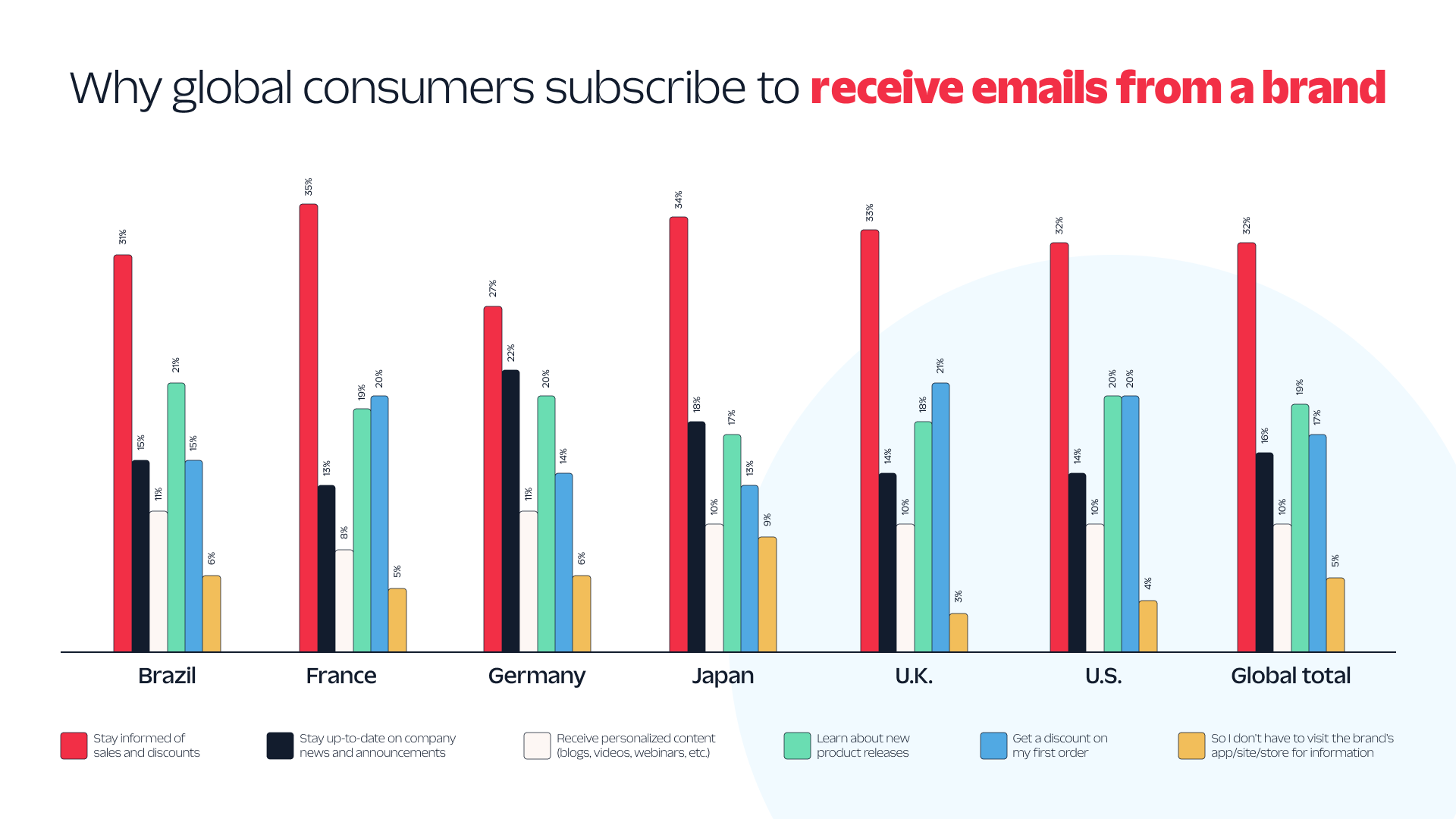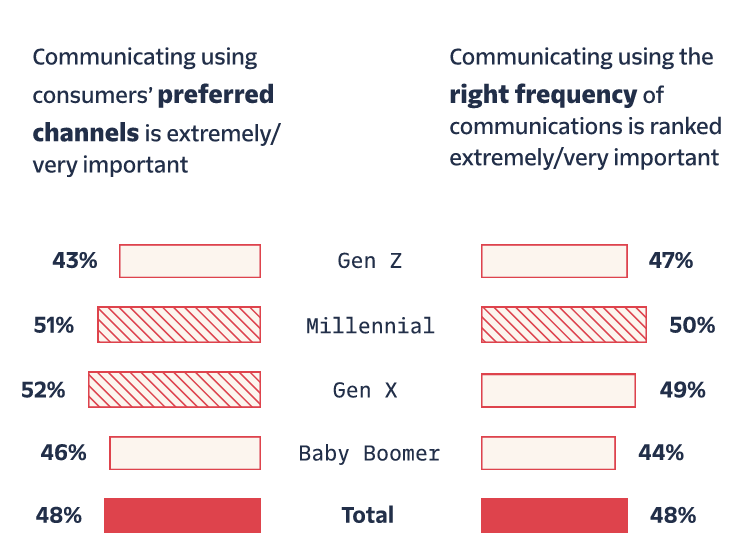Multichannel Marketing Statistics
Here is a comprehensive list of multichannel marketing statistics and trends that can help grow your business in 2023 and beyond.
Here is a comprehensive list of multichannel marketing statistics and trends that can help grow your business in 2023 and beyond.
Effective multichannel marketing is more than just using a variety of different touchpoints to promote your brand. It means using data to reach customers on their preferred channels at the right times with tailored content and communication.
In our 2023 State of Customer Engagement Report, 66% of consumers declared they would “quit a brand if their experience isn’t personalized,” and that number escalates to 75% among the Gen Z audience.
Learn about the current state of multichannel marketing, and use these insights to optimize your strategy.
A multichannel marketing approach broadens the opportunity for brands to meet their customers at the right place and time, both online and offline. It’s not about using every channel but the ones that will most benefit your customers and, in turn, your brand. To identify and prioritize your target marketing channels, you’ll need to collect and analyze user data.
Let’s look at the usage and impact of several popular channels to help you understand which ones might be right for your brand.
Even though radio predates every other medium on this list, its popularity hasn’t waned. And its modern counterpart, the podcast, continues to grow each year. The audio space proves it has staying power, so brands should consider where their place could be in it. That could look like recording and placing podcast ads, creating a podcast for your brand, or having company leaders go on other podcasts as guests.
Radio reaches more consumers than any other medium consistently every year, with 91% of adults listening to radio monthly in 2023. (Nielson)
Radio ads reach significantly more consumers than any major audio streaming channel. (Nielson)
Spotify is the most-listened-to audio brand per month, followed by YouTube Music, Pandora, and Apple Music. (Edison)
Podcast listening is at an all-time high, with 64% of the U.S. population listening – an estimated 183 million people. (Edison)
42% of the U.S. population are monthly podcast listeners – an estimated 120 million. (Edison)
The average number of podcast episodes listened to weekly is nine. (Edison)
67% of U.S. marketers report earning more than double their return on spend for podcast ads, and an additional 20% see a return of $6 or more for every dollar spent. (Acast)
Check out Twilio Segment’s own podcast, Good Data, Better Marketing.
Considering email’s low cost of entry and high revenue-generating potential, this format is a smart idea for any brand, especially those with smaller budgets.
Email produces a higher ROI than any other channel at $36 for every dollar spent. (Litmus)
Global revenue from email marketing is estimated to be over $10 billion in 2023. (Statista)
SMS marketing is a rapidly growing tool for marketers. The audience is massive and highly engaged, with much of the population owning cell phones and checking them frequently. Consider the following statistics from SendGrid’s 2023 Global Messaging Engagement Report:
79% of consumers say they check their email at least once daily, if not more.
22% of respondents listed email in their top 3 preferred communications channels—up from 18% from 2022.
17% of respondents said a primary reason they sign up to receive email and SMS messages from a brand is to get a discount on their first order.

If you sell products online, then you have to prioritize your website and make sure consumers can find it via search engines. That means investing in SEO and paid search ads, which many marketing leaders recognize as the top channels to focus on.
Online retail websites and search engines are the third and fourth biggest channels for brand and product discovery. (Statista)
According to CMOs worldwide, search advertising receives the second biggest share of the marketing budget. (Statista)
Businesses that invest in paid search with pay-per-click (PPC) ads earn an average of $2 for every $1 spent. (WebFX)
Search engines are the most preferred platform for 86% of consumers to get information. (HubSpot)
The world revolves around social media these days, so it’s no surprise that social marketing and advertising take up a lot of budgets. Social media has become a leading sales channel as well, so it’s a popular choice for e-commerce and retail brands to leverage for social commerce.
According to CMOs worldwide, social ads make up the biggest part of the marketing budget. (Statista)
82% of the U.S. population over 12 years of age use social media – an estimated 235 million people. (Edison)
Average daily time spent on social media per person is at its highest: 151 minutes. (Sprout Social)
Social media ad spend increased 25% from the previous year to over $137 billion, surpassing paid search’s $135 billion. (Sprout Social)
Facebook is the most popular platform for marketers, and TikTok is the fastest-growing platform. (Sprout Social)
Individually, these channels perform powerfully, but the real magic happens when you use these channels together. That’s because consumers want to communicate directly with brands, and they want to do it on their terms.
The top macro influence driving more investment in digital engagement reflects this demand: “the direct-to-consumer relationship revival.” Customers want to see relevant content and have their questions answered quickly. Paying careful attention to each channel they’re using and how they’re using it is crucial.
Consumers surveyed in Twilio’s State of Customer Engagement Report echo this sentiment, saying it’s important that brands interact with them on their preferred channels using the right frequency.

Different platforms offer unique advantages, and marketers should tailor their strategies to maximize the results across these channels. The impact could be huge if done right, considering the popularity and ROI potential of each channel.
The cost of a multichannel marketing program will vary for each company, depending on their earnings and the size of their audience, among other factors, like agency partners. The main expenses required are the software platform to manage your marketing channels, an advertising budget, and employee costs to create and manage content.
Overall, CMOs reported spending 9.1% of their total annual revenue on marketing. (Gartner)
The budget breakdown by cost reported by CMOs in 2023 includes 25.6% for paid media, 25.4% for marketing technology, 24.6% for labor, and 23.3% for agencies. (Gartner)
Brands spend an average of $20-$40k on multichannel marketing solutions like Twilio Engage. (Strata)
There are plenty of benefits for a well-executed multichannel marketing strategy: increased leads, better data collection and insights, and improved ROI.
Connect with a Segment expert who can share more about what Segment can do for you.
We'll get back to you shortly. For now, you can create your workspace by clicking below.
Multichannel marketing strategically uses specific marketing channels to connect with customers. Its goal is to foster customer engagement within these particular channels, ultimately driving sales through a series of interactions.
The main difference with omnichannel marketing is that it connects these channels. The primary goal is to craft a unified and consistent customer experience as individuals navigate across different touchpoints.
Yes, multichannel marketing is still effective. For example, Camping World took a multichannel marketing approach to reach their customers on their most effective channels and compete against the bigger brand names in their industry. By connecting with their customers via email and paid media campaigns, they increased conversion rates on paid channels by 35%, decreased cost-per-lead on paid channels by 16%, and increased conversion rates from marketing campaigns by 12%.
Twilio Engage is a customer engagement solution that allows businesses to leverage unified customer profiles to understand how people are interacting with their brand, and on what channels, in real time. Twilio Engage also allows teams to build highly nuanced, data-driven audiences to improve targeting, and orchestrate multi-step, multi-channel customer journeys that adapt with people’s real-time behavior.